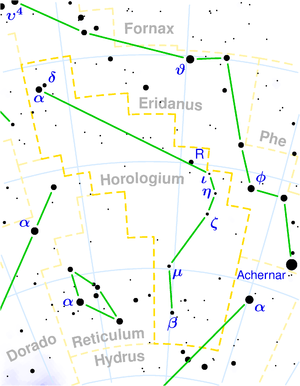 A small constellation of the southern sky lying below Eridanus, an indistinct group of stars east of its brightest star, Achernar. In our latitudes, only their northernmost part rises about 1 degree above the southern horizon in late autumn and early winter. The clock has only one star brighter than fourth magnitude and could easily have been placed in any of its neighboring constellations. There are various faint galaxies, the most interesting object being the globular cluster NGC 1261.
A small constellation of the southern sky lying below Eridanus, an indistinct group of stars east of its brightest star, Achernar. In our latitudes, only their northernmost part rises about 1 degree above the southern horizon in late autumn and early winter. The clock has only one star brighter than fourth magnitude and could easily have been placed in any of its neighboring constellations. There are various faint galaxies, the most interesting object being the globular cluster NGC 1261.
α Hor - The brightest star of the constellation is colored orange and has an apparent magnitude of 3.83. It marks the pendulum in the sky. It is 1,500 Kelvin cooler than our Sun. Therefore, its spectrum contains a large number of metal lines and molecular absorption bands that are only found in the spectra of cool stars. It is located at a distance of 117 light-years.
R a TW Hor - Red giants, long-period variable stars of the Mira Ceti type, whose brightness reaches a maximum of fifth magnitude. R Hor weakens to 14 mag over the course of more than one year, while it takes approximately 5-6 months for the star TW Hor.
NGC 1261
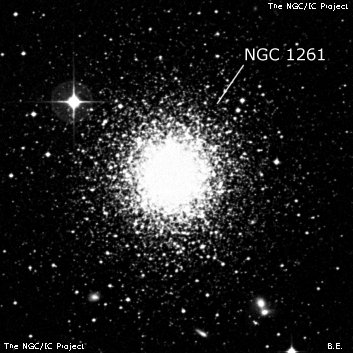
James Dunlop discovered NGC 1261 = D 337 = h2517 on 28 Sep 1826 with his 9" reflector from Parramatta and described "a very bright round nebula, about 1.5' diameter, pretty well defined and gradually bright to the centre. A small star north following." No mention is made of resolution, though it should have been possible (brightest stars mag 13.5).
JH observed the cluster twice, first describing it on 5 Dec 1834 as a "globular, bright; large; irregularly round; 2.5' diameter; all resolved into equal stars 14 mag. Has a star 9th mag 45? N.f. 3' distant." On his second sweep he logged "pretty bright; round; very gradually brighter in the middle; 3' across; resolved into stars of 15th magnitude. A very faint nebula (??) precedes." There is a close pair of extremely faint galaxies southwest of the globular, but I doubt Herschel could have picked these up.
400/500mm - 20" (7/8/02 - Magellan Observatory, Australia): at 212x, the resolution was a bit better in the halo than with the 18", but the blazing core was still unresolved.
Notes by Steve Gottlieb
NGC 1433
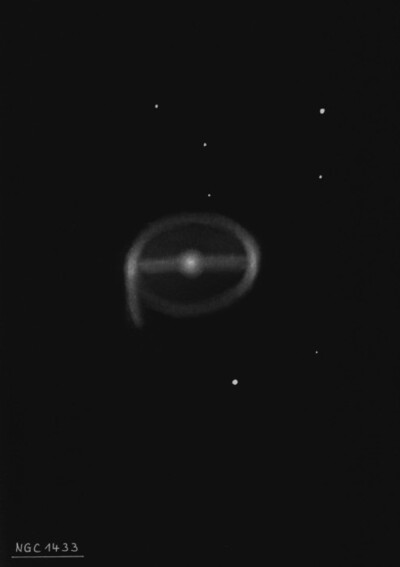
This barred spiral is the brightest member of the NGC 1433 group and part of the Dorado Cloud complex that includes NGC 1512, 1448, 1493 and 1411.
James Dunlop discovered NGC 1433 = D 426 on 28 Sep 1826 with his 9-inch f/12 speculum reflector and described "a very faint nebula, about 1' diameter, rather elliptical in the parallel of the equator; with a brightish point or condensation of the nebulous matter, a little to the preceding side of the centre." John Herschel first logged the galaxy on 14 Dec 1835 and recorded (h2580), "B, L, pmE, smbM; 100" long, 60" broad". His second sweep noted "vB, L, mE, vsmbM to nucleus = 10th mag star." Joseph Turner's sketch with the Great Melbourne Telescope on 10 Nov 1877, shows the thin bar running E-W with a well defined, bright nucleus. (p. 149 of his logbook).
300/350mm - 13.1" (2/18/04 - Costa Rica): fairly bright, large, oval 3:2 WNW-ESE, broad concentration with a large halo. The overall dimensions are ~3.5'x2.2'. I had a strong impression of extensions or the beginnings of two spiral arms (sketch made and verified); one arm begins at the west end and starts to curve towards the east on the south side while the other is symmetrically placed on the following end and hooks west on the north side. On images these arms connect to form a perfect barred ring. A mag 12 star lies 2.8' SW of center, beyond the halo.
Notes by Steve Gottlieb
NGC 1512
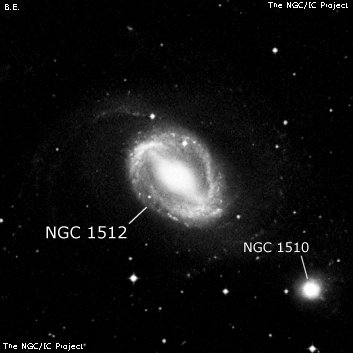
James Dunlop discovered NGC 1512 = D 466 = h2607 on 29 Oct 1826 and described "a small faint round nebula, about 25 arcseconds diameter, a little brighter in the centre: a star of 10th or 12th magnitude preceding the nebula." Dunlop made a single observation and his position is 10' SE of the galaxy (typical error).
John Herschel made 3 observations: On 24 Oct 1835 he logged "bright, large, slightly elongated, pretty suddenly brighter in the middle, 3' diameter; it is just north of a great group of large stars 6, 7 and 8th mag, scattered over two or three fields." On a second sweep he noted "Globular. bright, pretty large, round, 3' diameter. Resolved into stars barely perceptible." Finally, on a third sweep he recorded "B, R, gpmbM." Based on the second description, Herschel identified this object as a globular cluster in the GC.
Joseph Turner sketched NGC 1512 on 5 Dec 1876 with the Great Melbourne Telescope as sharply concentrated with a very small bright nucleus and faint halo. He commented "I cannot make out any distinct appearance of stars, although at times there is a suspicion of sparkling about the center - Indeed it has all the appearance of an ordinary nebula, round and much brighter in the centre. His unpublished lithograph (plate II, figure 11) shows a ring surrounding the core and nucleus. The east side of the halo or ring seems to be connected to the core by a bar.
Based on the GC, Dreyer identified NGC 1512 as a globular in the NGC. The IC 2, though, has a note from DeLisle Stewart "Not a globular cl, but an eF ring nebula". Oh a photograph taken at the Helwan Observatory in Egypt, the galaxy was described in 1921 as a Phi-type (barred-ring) spiral.
300/350mm - 13.1" (2/18/04 - Costa Rica): fairly bright, fairly large, oval 3:2 SW-NE. Sharply concentrated with a bright, 30" core. The tightly bound spiral "ring" was not seen, although there was some brightening at the southwest and northeast ends of the major axis, where the spiral arms emerge from the central bar. Forms a pair with NGC 1510 5' SW.
13.1" (11/29/86): faint, small, slightly elongated. Forms a pair with NGC 1510 5' SW. Very far south for viewing from Northern California.
Notes by Steve Gottlieb
NGC 1457
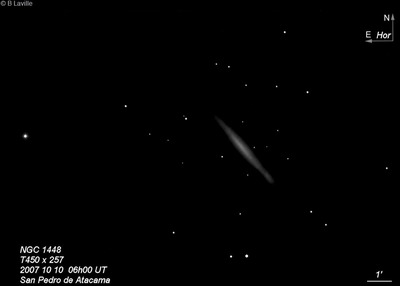
400/500mm - 18" (12/30/08): moderately bright, large, edge-on ~6:1 SW-NE, ~4.5'x0.8'. Contains a brighter, elongated core that increases to the center. A brighter star is close southeast of the core (1.4' from center) and a fainter star is near the northeast end. Situated at the midpoint of two mag 9.2/9.7 stars located 7.5' N and 7.5' S. Viewed at only 8? elevation.
Notes by Steve Gottlieb
NGC 1527
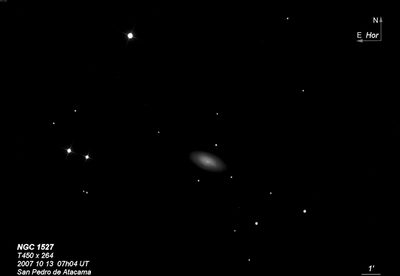
James Dunlop discovered NGC 1527 = D 409 on 28 Sep 1826 and described as "a very small and very faint round nebula, about 20" diameter." His position is 10' too far NE. JH independently found this galaxy (h2612) on 28 Dec 1834 while searching for D 409 and recorded "B, E, spmbM, growing more round internally; 60" long, 30" broad; pos 77?." On a second sweep he called it "pB, E, vsbM to a roundish nucleus." His third observation logged it as "pB, pmE, vsvmbM; seen in sweeping in vain for Dunlop 409." Herschel tentatively suggested this object corresponded with Dunlop 409 in the Cape Catalogue though the equivalence is not mentioned in the NGC. It's also possible that D 429 is a duplicate observation with a 1? error in declination (too far north).
600/800mm - 24" (11/18/12 - Magellan Observatory, Australia): very bright, fairly large, elongated nearly 3:1 WSW-ENE, 3.2'x1.2'. Very sharply concentrated with a blazing core that is elongated 2:1, increasing to a very small, intense nucleus. A mag 14 star lies 1.2' N of center and a mag 15.3 star is a similar distance south of center. Probable member of the Dorado Group.
Notes by Steve Gottlieb
NGC 1411
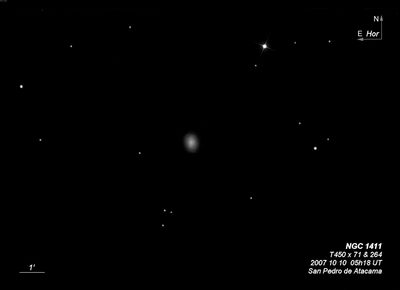
300/350mm - 13.1" (10/10/86): moderately bright, fairly small, round, bright core. One of farthest southern galaxies easily viewed from Northern California.
600/800mm - 24" (11/18/12 - Magellan Observatory, Australia): very bright, fairly large, elongated 4:3 ~N-S, ~2'x1.5'. Very sharply concentrated with an intensely bright 20" core and fairly even surface brightness halo that gradually fades out. IC 1970 lies 25' WNW. One of the brighter members of the NGC 1433 subgroup of the Dorado Group complex.
Notes by Steve Gottlieb
NGC 1510
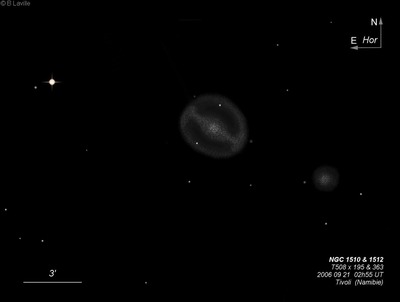
John Herschel discovered NGC 1510 = h2606 on 4 Dec 1836 and recorded "F; R; vgpmbM, 80" dia. Not resolved. A companion to Dunlop 466 [NGC 1512]." His position is accurate.
300/350mm - 13.1" (2/18/04 - Costa Rica): faint, very small, round, only 20" diameter. Forms an equilateral triangle with two mag 13.5 stars ~1.8' S and 1.7' WSW. Located 5' SW of NGC 1512.
13.1" (11/29/86): not seen although far south from northern California. Forms a pair with brighter NGC 1512.
Notes by Steve Gottlieb